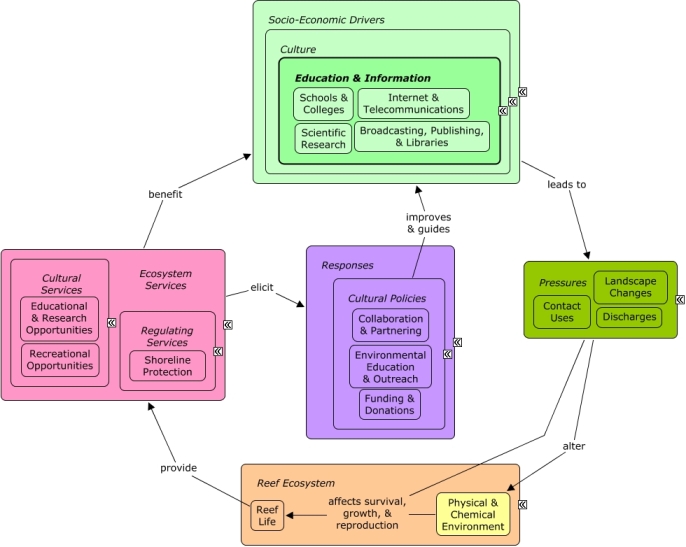ReefLink Database

Education & Information
The Education and Information sectors consists of schools, colleges, instruction and training programs that provide instruction in various subjects, organizations that conduct scientific research, and organizations that collect and distribute information (NAICS 2007).
CMap

CMap Description
Growing coastal development changes the cultural identity of a community, creating an increased need for education and information. Infrastructure is needed to support the Education and Information sectors, including buildings and roads, and this infrastructure results in landscape changes and discharges. Information sectors may benefit from aesthetic value provided by reefs, including photography and video. Coastal schools & colleges may also directly benefit from shoreline protection. Reef ecosystems also provide educational and research opportunities for students and scientific researchers. Scientific research can contribute to the effectiveness of decisions by enhancing our understanding of ecosystems. Collaboration and funding can improve, increase, and guide scientific research. Decision-makers may also utilize schools & colleges to improve environmental education.Citations
More than 50 citations. Click here to load.
| Citation | Year | Study Location | Study Type | Database Topics |
|---|
Management Options
More than 50 management options. Click here to load.
| Management Option | Description | Sources | Database Topics |
|---|
Laws
| Legal Citation | Purpose of Law | Management Organization | Database Topics |
|---|---|---|---|
| Coral Reef Conservation Act of 2000, 16 United States Code § 6401 (2000). | To preserve, sustain, and restore the condition of coral reef ecosystems, to promote the wise management and sustainable use of coral reef ecosystems, to benefit local communities and the Nation, to develop sound scientific information on the condition of coral reef ecosystems and threats to the ecosystems, to assist in the preservation of coral reefs by supporting and financing conservation programs including local and non-governmental programs, establish a formal mechanism for collecting and allocating monetary donations from the private sector to be used for coral reef conservation projects Application to Coral Reefs:Allowed the development of programs and projects, and provided financing for developing sound scientific data to preserve and restore coral reefs. Continued the Coral Reef Task Force and Coral Reef Initiative started under Executive Order 13089 (1998). Legislative Actions:Provided funding for matching grants, encouraged education and outreach, encouaged cooperative conservation and management through partnerships with other federal, state, regional and local partners including citizen groups. Comments:The Act is administrative, not regulatory. It established four major programs; (1) The National Coral Reef Action Strategy established goals for research, monitoring and conservation, (2, 3) The Coral Reef Conservation Program and Coral Reef Conservation Fund provided financial assistance for coral reef projects, (4) the National Program facilitated cooperative work between federal, state and regional efforts that work to improve coral reef ecosystems. The National Program also enhanced the public awareness of coral reefs through educational programs. The Act incorporated Executive Order 13,089 and provided coordinated funding activities through twelve federal agencies and seven states. |
National Oceanic and Atmospheric Administration Jurisdiction: United States; US Coral Reefs |
Biocriteria; Biological Monitoring, Mapping, & Scientific Research; Corporate Responses; Education & Information; Environmental Education & Outreach; Environmental Monitoring, Mapping, & Scientific Research; Fishing & Harvesting Management; Food & Raw Materials; Funding & Incentives; Marine Debris; Marine Protected Areas; Microorganisms; Public Administration; Remediation; Utilities |
